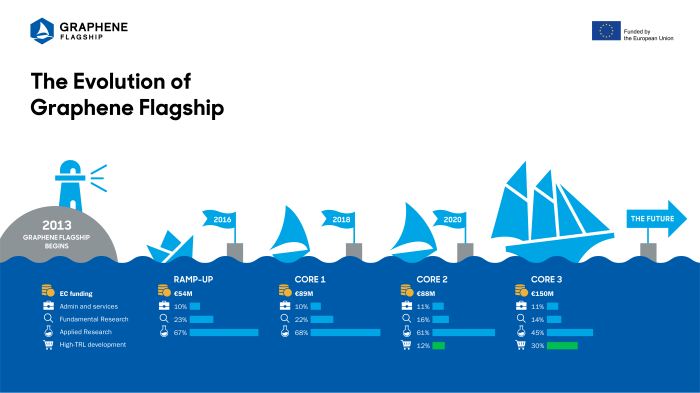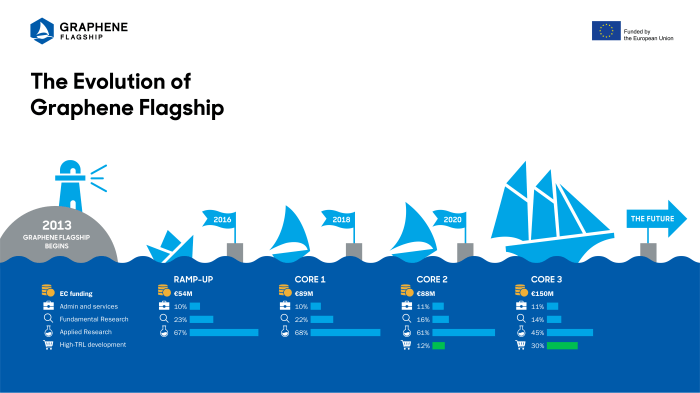Has eu graphene flagship hit its 10 year targets – Has the EU Graphene Flagship hit its 10-year targets? This question is a hot topic in the world of materials science and technological advancement. The EU Graphene Flagship, a massive research initiative launched in 2013, aimed to unlock the potential of graphene, a revolutionary material with incredible properties.
With a decade of research under its belt, the Flagship has made significant strides in pushing the boundaries of graphene’s applications.
The initiative has focused on developing graphene-based technologies for various sectors, including electronics, energy, and healthcare. From flexible displays to advanced batteries, the potential applications of graphene are vast and exciting. But has the Flagship achieved its ambitious goals?
Let’s delve into the progress made, the challenges faced, and the future prospects of this groundbreaking research initiative.
The EU Graphene Flagship
The EU Graphene Flagship is a large-scale research initiative funded by the European Union. It aims to accelerate the development and application of graphene and related two-dimensional materials. This ambitious project brings together scientists, engineers, and industrial partners from across Europe to push the boundaries of graphene research and unlock its transformative potential across various industries.
Project Goals and Objectives
The Graphene Flagship’s primary goal is to translate groundbreaking research into real-world applications, benefiting society and driving economic growth. It aims to achieve this by:
- Developing new and innovative graphene-based technologies.
- Establishing a robust European graphene industry.
- Fostering collaboration between academia and industry.
- Promoting the ethical and responsible use of graphene.
Timeline and Duration
The Graphene Flagship is a long-term project with a planned duration of ten years. It was launched in 2013 and is expected to conclude in 2023. The project is divided into several phases, each focusing on specific research areas and objectives.
Key Research Areas
The Graphene Flagship targets a wide range of research areas, including:
- Graphene synthesis and production: This area focuses on developing scalable and cost-effective methods for producing high-quality graphene. Researchers are exploring different approaches, including chemical vapor deposition (CVD), exfoliation, and epitaxial growth, to optimize graphene production for various applications.
- Graphene characterization and analysis: Understanding the properties of graphene is crucial for its successful application. This research area involves developing advanced characterization techniques to analyze the structure, morphology, and electronic properties of graphene. Researchers use sophisticated tools like atomic force microscopy (AFM), transmission electron microscopy (TEM), and Raman spectroscopy to gain insights into the intricate nature of graphene.
- Graphene device fabrication and integration: This area focuses on developing innovative methods for incorporating graphene into various devices. Researchers are exploring techniques like microfabrication, lithography, and printing to create graphene-based components for electronics, sensors, and energy storage applications.
- Graphene applications in electronics: Graphene’s exceptional electrical conductivity makes it a promising material for next-generation electronics. Researchers are investigating its potential in transistors, flexible displays, and high-frequency circuits. For example, graphene’s high electron mobility and transparency make it ideal for developing transparent and flexible touchscreens, revolutionizing the way we interact with technology.
- Graphene applications in energy: Graphene’s large surface area and excellent electrical conductivity make it an ideal material for energy storage and generation applications. Researchers are exploring its use in batteries, fuel cells, and solar cells. For instance, graphene-based electrodes can significantly improve the performance and lifespan of lithium-ion batteries, paving the way for more efficient and sustainable energy solutions.
- Graphene applications in biomedicine: Graphene’s unique properties, such as its biocompatibility and ability to interact with biological systems, make it a promising material for biomedical applications. Researchers are investigating its potential in drug delivery, biosensing, and tissue engineering. For example, graphene-based nanoparticles can be used to deliver drugs directly to tumor cells, increasing treatment efficacy and reducing side effects.
Ten-Year Targets and Achievements: Has Eu Graphene Flagship Hit Its 10 Year Targets

The EU Graphene Flagship, a €1 billion research initiative, set out with ambitious goals for graphene and related 2D materials research over a ten-year period. These goals encompassed a wide range of scientific and technological advancements, aiming to translate fundamental research into tangible applications across various sectors.
Progress Made Towards Targets
The Flagship has made significant strides towards achieving its ambitious goals. This progress can be assessed across various key areas, highlighting the impact of graphene research on society.
| Target Area | Achieved Progress | Remaining Challenges | Impact on Society |
|---|---|---|---|
| Materials Science and Production | Development of high-quality graphene and other 2D materials, including large-scale production methods like CVD and exfoliation. | Scaling up production to meet industrial demand, cost reduction, and addressing environmental concerns related to production processes. | Enabling the use of graphene in a wide range of applications, from electronics to composites and energy storage. |
| Electronics and Photonics | Demonstrated graphene’s potential in flexible electronics, high-frequency transistors, and transparent electrodes for displays and solar cells. | Improving device performance, integration with existing technologies, and finding applications that leverage graphene’s unique properties. | Enabling faster, more efficient, and flexible electronic devices, paving the way for next-generation technologies. |
| Energy and Environment | Developed graphene-based batteries, supercapacitors, and sensors for environmental monitoring and pollution control. | Improving energy storage capacity, cycle life, and cost-effectiveness of graphene-based energy solutions. | Contributing to a cleaner and more sustainable energy future, with applications in renewable energy generation and storage. |
| Biomedicine and Healthcare | Explored graphene’s potential in drug delivery, bioimaging, and tissue engineering, demonstrating its biocompatibility and ability to interact with biological systems. | Ensuring long-term safety and efficacy of graphene-based biomedical applications, addressing ethical considerations, and gaining regulatory approval. | Improving diagnostics, treatment options, and healthcare outcomes, leading to personalized medicine and advanced therapies. |
Notable Successes and Breakthroughs
The EU Graphene Flagship has witnessed numerous breakthroughs and notable successes, driving the field of graphene research forward.
“The development of large-scale, high-quality graphene production methods has been a significant achievement, paving the way for its widespread adoption in various industries.”
“Graphene’s exceptional electrical conductivity has led to the development of high-performance transistors, paving the way for faster and more energy-efficient electronics.”
“Graphene’s ability to enhance the performance of batteries and supercapacitors has opened new avenues for energy storage, contributing to a more sustainable energy future.”
Real-World Applications
Graphene research has already translated into a range of real-world applications, demonstrating its practical impact across various sectors.* Electronics:Graphene is being used in touchscreens, flexible displays, and high-speed transistors. Samsung has incorporated graphene into its latest smartphones for improved heat dissipation and conductivity.
Composites
Graphene is being added to polymers to enhance their strength, conductivity, and barrier properties, leading to lighter and more durable materials for aerospace, automotive, and construction industries.
Energy Storage
Graphene-based batteries and supercapacitors are being developed for electric vehicles, portable electronics, and grid-scale energy storage, offering faster charging and higher energy density.
Biomedicine
Discover the crucial elements that make europe licensed cargo drone eu funding the top choice.
Graphene is being explored for drug delivery, bioimaging, and tissue engineering, with potential applications in cancer therapy, diagnostics, and regenerative medicine.
Impact and Significance
The EU Graphene Flagship, with its ambitious goals and collaborative approach, has the potential to revolutionize numerous industries and positively impact society. Graphene, a wonder material with exceptional properties, holds the key to unlocking groundbreaking technological advancements.
Impact on Industries
Graphene’s remarkable properties, such as its high electrical conductivity, exceptional strength, and flexibility, make it a game-changer for various industries.
- Electronics:Graphene’s exceptional conductivity can significantly enhance the performance of electronic devices, leading to faster and more efficient transistors, flexible displays, and transparent electrodes for touchscreens. For instance, researchers at the University of Manchester have developed graphene-based transistors that operate at speeds exceeding silicon-based counterparts.
- Energy:Graphene can revolutionize energy storage and generation. Its high surface area and conductivity make it an ideal material for supercapacitors, which can store energy much faster than traditional batteries. Graphene can also enhance solar cell efficiency by increasing light absorption and charge transport.
- Healthcare:Graphene’s biocompatibility and excellent electrical conductivity open up possibilities in healthcare. Graphene-based sensors can detect disease markers at early stages, and its unique properties can enhance drug delivery and tissue regeneration. For example, researchers at the University of Cambridge have developed graphene-based biosensors for early cancer detection.
- Materials Science:Graphene’s exceptional strength and lightweight nature make it a promising material for composites, reinforcing existing materials, and creating new lightweight and durable structures. This could lead to lighter and stronger aircraft, cars, and buildings.
- Environmental Sustainability:Graphene can play a vital role in tackling environmental challenges. Its high surface area can be used to filter pollutants from water and air, while its unique properties can enhance the efficiency of renewable energy technologies.
Economic and Societal Benefits
The successful development and widespread adoption of graphene technologies could bring significant economic and societal benefits.
- Job Creation:The graphene industry is expected to create numerous jobs across various sectors, from research and development to manufacturing and applications. The EU Graphene Flagship alone has fostered a vibrant ecosystem of graphene companies and research institutions, contributing to job creation and economic growth.
- Innovation and Competitiveness:Graphene’s potential to revolutionize industries will drive innovation and boost Europe’s competitiveness in the global market. By investing in graphene research and development, Europe can maintain its technological leadership and create new opportunities for economic growth.
- Improved Quality of Life:Graphene-based technologies can improve the quality of life for individuals and communities. From faster and more efficient electronic devices to improved healthcare solutions and sustainable energy technologies, graphene has the potential to address pressing societal challenges.
- Increased Sustainability:Graphene can contribute to a more sustainable future by enabling the development of energy-efficient technologies, reducing waste, and minimizing environmental impact. For instance, graphene-based composites can replace heavier and less sustainable materials in various applications, leading to reduced energy consumption and emissions.
Comparison with Global Graphene Research Initiatives, Has eu graphene flagship hit its 10 year targets
The EU Graphene Flagship is a leading force in global graphene research, but it faces competition from other initiatives worldwide.
- United States:The US has also invested significantly in graphene research through government agencies and private companies. The National Graphene Association (NGA) promotes graphene research and development in the US, fostering collaboration between academia and industry.
- China:China has emerged as a major player in graphene research, with a strong focus on commercialization and industrial applications. The Chinese government has established several graphene research centers and provided significant funding for graphene-related projects.
- South Korea:South Korea has also made significant progress in graphene research, with a strong focus on materials science and electronics. The Korean government has established the National Graphene Institute (NGI) to promote graphene research and development.
Future Prospects and Challenges
Despite the significant progress made, graphene research and development face challenges that need to be addressed to realize its full potential.
- Scaling Up Production:One of the key challenges is scaling up graphene production to meet the demands of various industries. While research-scale production methods exist, developing cost-effective and scalable production processes is crucial for widespread adoption.
- Standardization and Characterization:Lack of standardized methods for characterizing graphene materials and measuring their properties can hinder the development of reliable and reproducible applications. Establishing standardized procedures for characterization and quality control is essential for the growth of the graphene industry.
- Commercialization and Market Adoption:Bringing graphene-based technologies to market requires overcoming regulatory hurdles and demonstrating their value proposition to potential customers. Effective communication and collaboration between researchers, industry stakeholders, and policymakers are crucial for successful commercialization.
Key Players and Collaborations
The EU Graphene Flagship has brought together a diverse range of key players, including leading research institutions, universities, and companies, to drive the development and application of graphene. These collaborative efforts have been instrumental in achieving the Flagship’s ambitious goals.The collaborative nature of the EU Graphene Flagship is a crucial aspect of its success.
This collaboration has not only fostered the sharing of knowledge and expertise but also accelerated the translation of research findings into real-world applications.
Key Institutions and Research Groups
The EU Graphene Flagship comprises a network of over 170 academic and industrial partners from across Europe. These institutions and research groups play a vital role in driving the research and development of graphene.
- Graphene Flagship Core 1:This core focuses on developing the fundamental science and technology of graphene. Key institutions involved include Chalmers University of Technology (Sweden), the University of Manchester (UK), and the Institute of Photonic Sciences (Spain).
- Graphene Flagship Core 2:This core focuses on developing applications of graphene in electronics, photonics, and composites. Key institutions involved include the Italian Institute of Technology (Italy), the University of Cambridge (UK), and the Technical University of Munich (Germany).
- Graphene Flagship Core 3:This core focuses on developing applications of graphene in energy, sensors, and biotechnology. Key institutions involved include the University of Copenhagen (Denmark), the University of Helsinki (Finland), and the University of Vienna (Austria).
Industry Partners
The EU Graphene Flagship also involves a significant number of industry partners, including large corporations and small and medium-sized enterprises (SMEs). These partners play a critical role in translating graphene research into commercial products and applications.
- Airbus:Airbus is using graphene to develop lightweight and durable materials for aircraft components.
- BASF:BASF is developing graphene-based composites for use in automotive and other industries.
- Nokia:Nokia is using graphene to develop high-performance antennas and other communication components.
- IBM:IBM is developing graphene-based transistors for use in next-generation computing devices.
Funding and Support from the European Union
The EU Graphene Flagship is a major initiative funded by the European Union’s Horizon 2020 research and innovation program. The Flagship has received €1 billion in funding over ten years, making it one of the largest research projects ever funded by the EU.
“The EU Graphene Flagship is a prime example of how the European Union can support ambitious and impactful research initiatives. The funding provided by the EU has been instrumental in driving graphene research and development, and has helped to position Europe as a global leader in this field.”
Impact of International Collaborations
The EU Graphene Flagship has fostered strong international collaborations with research groups and companies from around the world. These collaborations have helped to accelerate graphene research and development, and have led to the development of new technologies and applications.
- Collaboration with the United States:The EU Graphene Flagship has collaborated with researchers at the National Institute of Standards and Technology (NIST) and other institutions in the United States on projects related to graphene characterization and standardization.
- Collaboration with Asia:The EU Graphene Flagship has collaborated with researchers in China, Japan, and South Korea on projects related to graphene production, device fabrication, and applications in electronics and energy.





